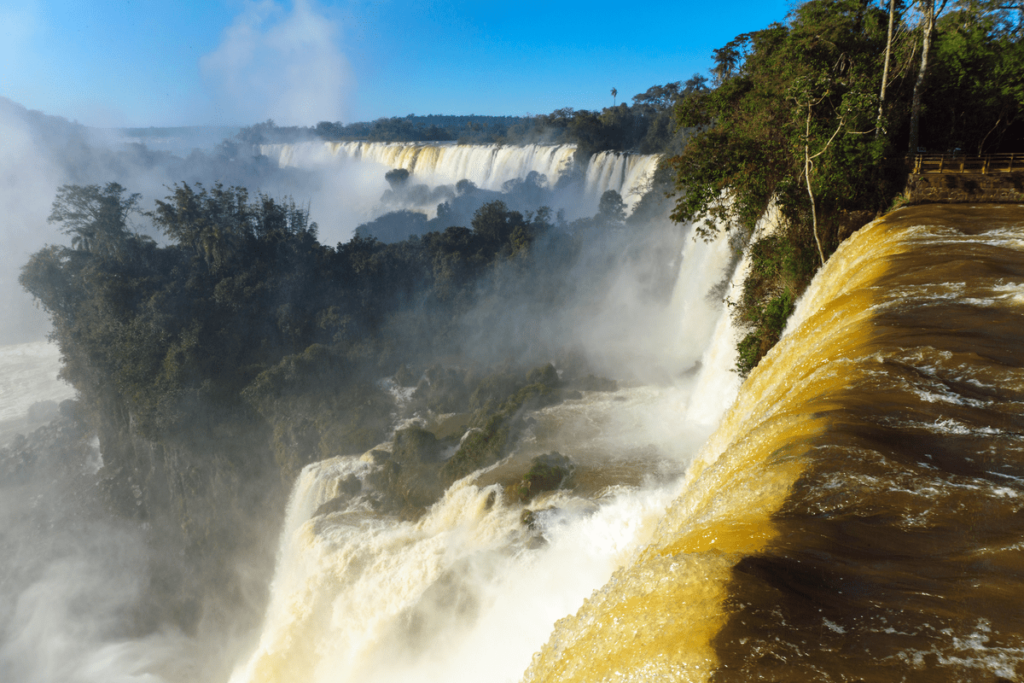Iguazu Falls: The Majestic Waterfall of Argentina and Brazil

Introduction
Iguazu Falls, one of the most spectacular and expansive waterfall systems in the world, is located on the border between Argentina and Brazil. This magnificent natural wonder consists of 275 individual falls spread over a stretch of nearly 1.7 miles (2.7 kilometers) along the Iguazu River. Renowned for their breathtaking beauty and sheer power, Iguazu Falls attract millions of visitors each year, offering an unforgettable experience of nature’s grandeur.
Geographical and Geological Features
Iguazu Falls are situated in the Iguazu National Park, a UNESCO World Heritage site that spans both Argentina and Brazil. The falls are formed where the Iguazu River tumbles over the edge of the Paraná Plateau, creating a dramatic series of cascades.
- Height and Width: The falls vary in height from 197 to 269 feet (60 to 82 meters). The most impressive section, known as the “Devil’s Throat” (Garganta del Diablo), features a U-shaped cliff that is 269 feet high and 490 feet (150 meters) wide.
- Water Flow: Depending on the season, the flow rate of the Iguazu River can vary significantly, with peak flow during the rainy season between November and March. This fluctuation dramatically affects the appearance and power of the falls.

Attractions and Activities
Visitors to Iguazu Falls can engage in a variety of activities that provide different perspectives and experiences of this natural wonder.
- Walkways and Viewing Platforms: Both the Argentine and Brazilian sides of the falls offer extensive networks of walkways and viewing platforms. The Argentine side provides closer, more intimate views, allowing visitors to get up close to the thundering water. The Brazilian side offers panoramic vistas that capture the entire sweep of the falls.
- Boat Tours: Exciting boat tours take visitors to the base of the falls, where they can feel the full force and spray of the water. These tours are a thrilling way to experience the falls’ power and grandeur.
- Helicopter Rides: For an aerial perspective, helicopter tours offer breathtaking views of the falls and the surrounding rainforest. This unique vantage point showcases the falls’ full scale and beauty.
- Hiking and Nature Trails: Both national parks feature well-maintained trails that wind through the lush subtropical rainforest, home to diverse flora and fauna. Guided hikes provide opportunities to learn about the region’s ecology and wildlife.
Ecological Importance
Iguazu Falls are located in one of the most biologically diverse regions in the world. The surrounding rainforest is a crucial habitat for numerous species of plants and animals, many of which are endangered or endemic.
- Flora: The humid environment around the falls supports a rich variety of plant life, including towering trees, vibrant orchids, and dense undergrowth. This lush vegetation provides essential habitat and food sources for wildlife.
- Fauna: The national parks are home to an array of wildlife, including jaguars, tapirs, giant anteaters, and over 400 species of birds. The falls’ unique ecosystem supports diverse aquatic life and serves as a vital water source for the region.

Cultural Significance
For the indigenous Guarani people, Iguazu Falls hold deep cultural and spiritual significance. According to Guarani legend, the falls were created by a deity who, in a fit of rage, split the river in two, creating the dramatic cascades. The falls continue to be a sacred site and an important part of Guarani heritage.
Conservation Efforts
Iguazu Falls and the surrounding national parks face several environmental threats, including deforestation, pollution, and climate change. Conservation efforts are essential to protect this natural wonder and its diverse ecosystems.
- Protected Area Management: Both Argentina and Brazil have established national parks to safeguard the falls and their surrounding environments. Effective management and enforcement of conservation regulations are critical.
- Sustainable Tourism: Promoting eco-friendly tourism practices helps minimize the environmental impact of visitors and supports local communities. Initiatives include waste management, eco-friendly accommodations, and educational programs.
- Habitat Restoration: Efforts to restore degraded habitats and reforest areas within the national parks are vital for maintaining biodiversity and ecological balance.









